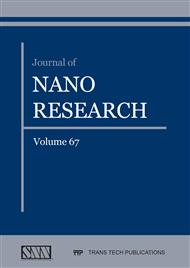[1]
V.I Shubayev, T.R. Pisanic 2nd, S. Jin, Magnetic nanoparticles for theragnostics, Adv. Drug. Deliv. Rev. 61 (2009) 467-477.
DOI: 10.1016/j.addr.2009.03.007
Google Scholar
[2]
W. Wu, Q. He, C. Jiange, Magnetic iron oxide nanoparticles: Synthesis and surface functionalization strategies, Nanoscale Res. Lett. 3 (2008) 397-415.
DOI: 10.1007/s11671-008-9174-9
Google Scholar
[3]
A. Carpentier, D. Chauvet, V. Reina, K. Beccaria, D. Leclerg, R.J. McNichols, A. Gowda, P. Cornu, J.Y. Delattre, MR-guided laser-induced thermal therapy (LITT) for recurrent glioblastomas, Lasers Surg. Med. 44 (2012) 361-368.
DOI: 10.1002/lsm.22025
Google Scholar
[4]
S. Laurent, S. Dutz, U. Hafeli, M. Mahmoudi, Magnetic fluid hyperthermia: Focus on superparamagnetic iron oxide nanoparticles, Adv. Colloid Interface Sci. 166 (2011) 8-23.
DOI: 10.1016/j.cis.2011.04.003
Google Scholar
[5]
L.H. Reddy, J.L. Arias, J. Nicolas, P. Couvreur, Magnetic nanoparticles: Design and characterization, toxicity, and biocompatibility, pharaceutical and biomedical applications, Chem. Rev. 112 (2012) 5818-5878.
DOI: 10.1021/cr300068p
Google Scholar
[6]
D.L. Huber, Synthesis, properties, and applications of iron nanoparticles, Small 1 (2005) 482-501.
Google Scholar
[7]
A.K. Gupta, R.R. Naregalkar, V.D. Yaidya, M. Gupta, Recent advances on surface engineering of magnetic iron oxide nanoparticles and their biomedical applications, Nanomedicine 2 (2007) 23-39.
DOI: 10.2217/17435889.2.1.23
Google Scholar
[8]
D. Illes, E. Tombacz, M. Szekeres, I. Toth, A. Szabo, B. Ivan, Novel carboxylated peg-coating on magnetite nanoparticles designed for biomedical applications, J. Magn. Magn. Mater. 380 (2015) 132-139.
DOI: 10.1016/j.jmmm.2014.10.146
Google Scholar
[9]
T.J. Yoon, H. Lee, H. Shao, R. Weissleder, Highly magnetic core-shell nanoparticles with unique magnetization mechanism, Angew Chem. Int. Ed. 50 (2011) 4663-4666.
DOI: 10.1002/anie.201100101
Google Scholar
[10]
J. Park, K. An, Y. Hwang, J.G. Park, H.J. Noh, J.Y. Kim, J.H. Park, N.M. Hwang, T. Hyeon, Ultra-large-scale syntheses of monodispersed nanocrystals, Nat. Mater. 3 (2004) 891-895.
DOI: 10.1038/nmat1251
Google Scholar
[11]
S. Peng, C. Wang, J. Xie, S. Sun, Synthesis and stabilization of monodisperse fe nanoparticles, J. Am. Chem. Soc. 128 (2006) 10676-10677.
DOI: 10.1021/ja063969h
Google Scholar
[12]
L.M. Bronstein, X. Huang, J. Retrum, A. Schmucker, M. Pink, B. Stein, B. Dragnea, Influence of iron oleate complex structure on iron oxide nanoparticle formation, Chem. Mater. 19 (2007) 3624-3632.
DOI: 10.1021/cm062948j
Google Scholar
[13]
P.H. Christensen, S. Mørup, J.W. Niemantsverdriet, Particle size determination of superparamagnetic α-Fe in carbon-supported catalysts by in situ Mössbauer spectroscopy, J Phys Chem 89 (1985) 4898-4900.
DOI: 10.1021/j100269a002
Google Scholar
[14]
G.M. Costa, C. Blanco-Andujar, E. De Grave, Q. Pankhurst, Magnetic nanoparticles for in vivo use: A critical assessment of their composition, J. Phys. Chem. B 118 (2014) 11738-11746.
DOI: 10.1021/jp5055765
Google Scholar
[15]
E. Petala, K. Dimos, A. Douvalis, T. Bakas, J. Tucek, R. Zboril, M.A. Karakassides, Nanoscale zero-valent iron supported on mesoporous silica: Characteriaztion and reactivity for Cr(VI) removal from aqueous solution, J. Hazard. Mater. 261 (2013) 295-306.
DOI: 10.1016/j.jhazmat.2013.07.046
Google Scholar
[16]
S. Mørup Mössbauer effect in small particles, Hyperfine Interact. 60 (1990) 959-974.
DOI: 10.1007/bf02399910
Google Scholar


